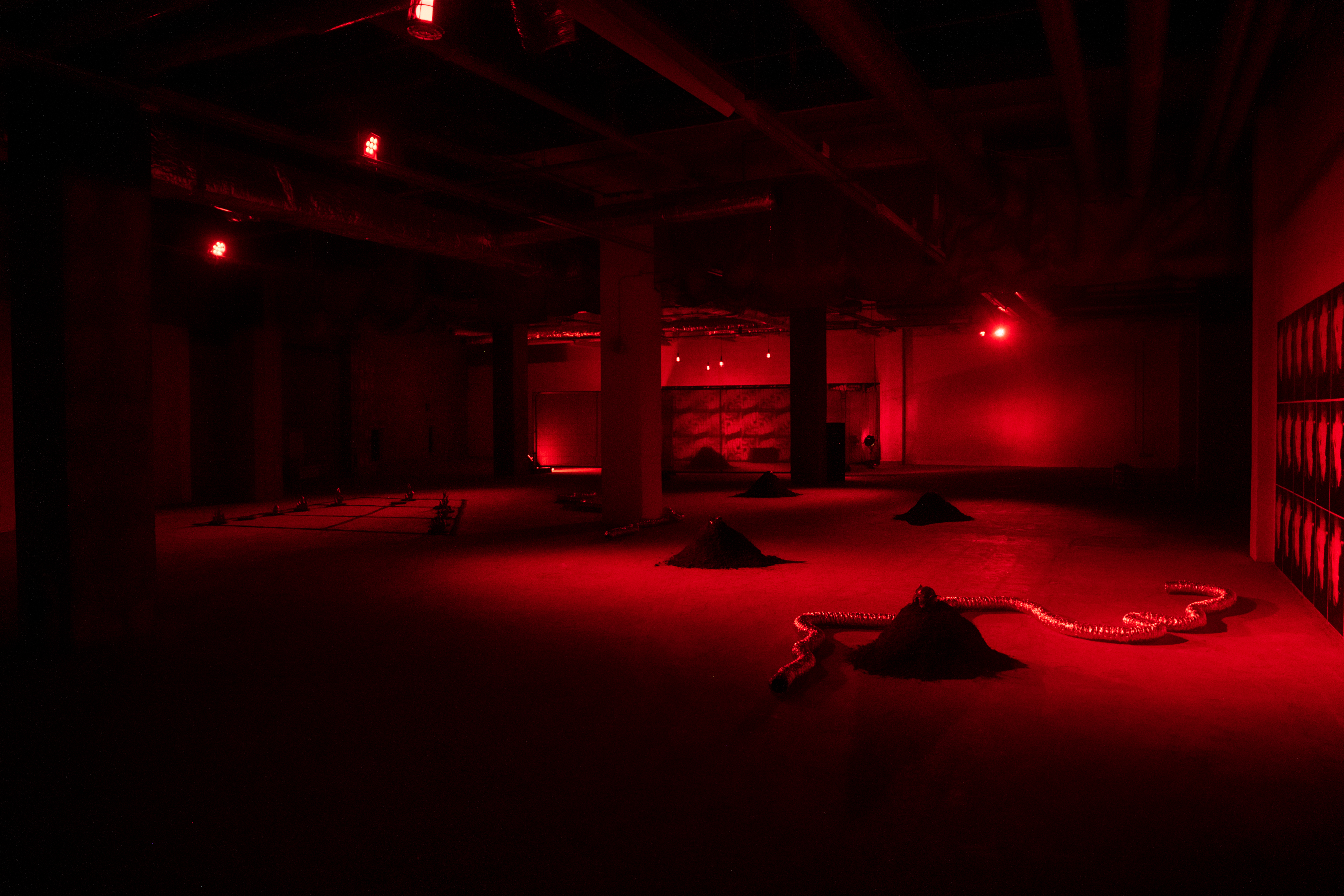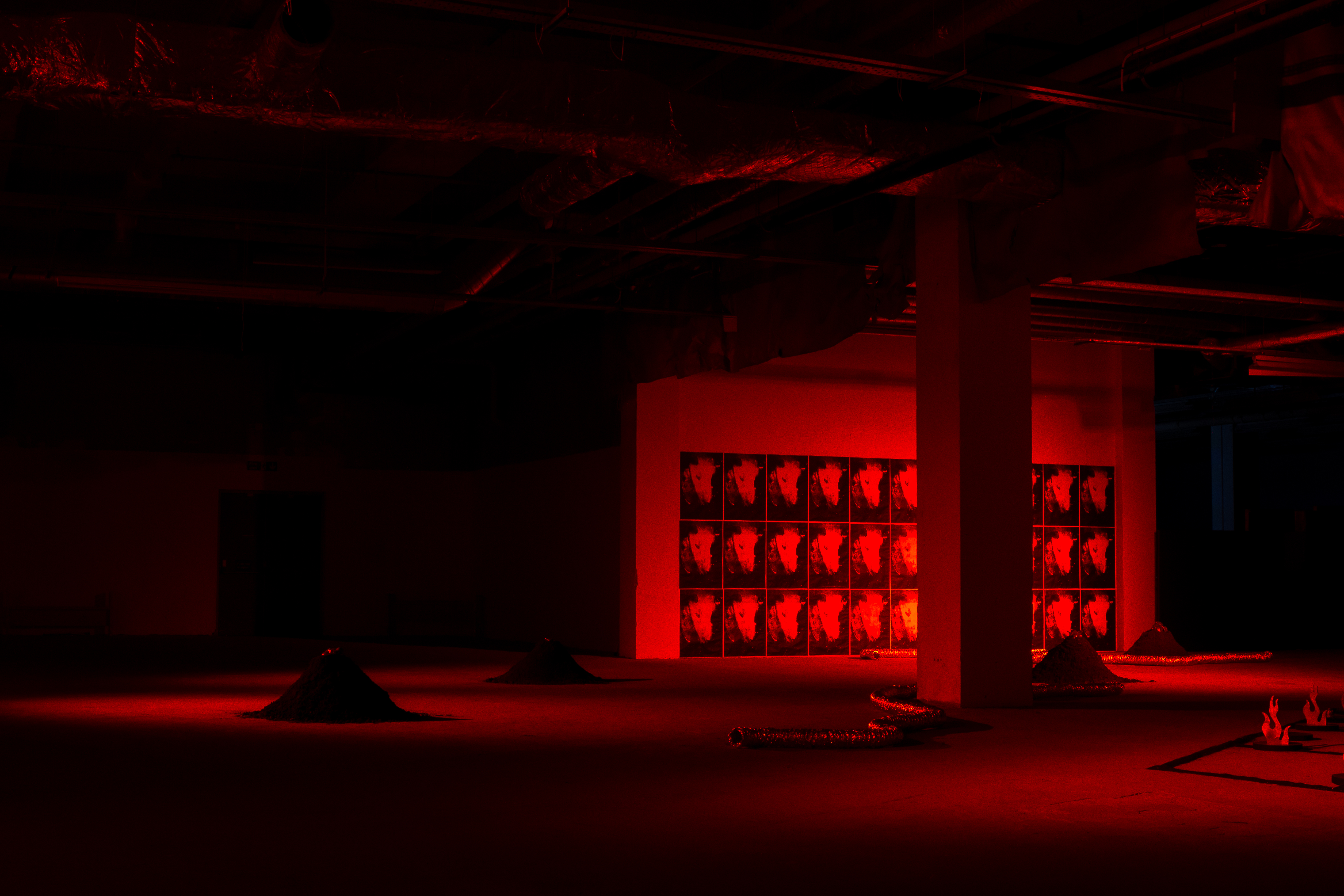Kelsey Cruz-Martin
Interview by Dan Guthrie
-
Published in March 2023
-

A Flowing Body of Snake, installation view at SHIFT, Cardiff, 2023. Image by Jasmine De Silva
Hey Kelsey, congrats on your show A Flowing Body of Snake at SHIFT! For those who didn’t manage to make it down to Cardiff to see it in-person, can you talk us through the work?
Thanks, Dan! Yeah, sure. SHIFT is an old shopping centre so it’s not your average gallery set up, nor entrance for that matter. At street level you can hear distant, drowned out electronic music and you can see a red glow from the top of the stairs. As you make your way down to the gallery, the first thing you see is an s-shaped strip of aluminium ducting placed to resemble the body of a snake wrapped around an ambiguous mound. To the left of the gallery, a large floor sculpture of an asymmetrical diagram drawn with snake sand mimics the Mexican/Spanish vowel chart, aluminium casts of flames, eggs and seeds sit on top of black disks. To the right a seven-metre wall has a screen-printed image of snakeskin viewed in microscopic detail that is repeated and wallpapered to the building interior.
The sound piece bleeds out onto raku'd ceramic sculptures embedded in mounds of compost that navigate the viewer like a snake slithering through the space. As you continue to walk through, the sound piece gains clarity but it’s never quite clear until you approach the large, womb-like structure. Steel Heras fencing lined with red transparent welding curtains creates an enclosed listening area for an 18-minute spoken word recording featuring menacing drones, tense rhythms and fitful echoes. Inside the structure, a stock image of aluminium ducting is similarly printed and repeated, resembling a coiled snake, suggesting intestines, or the unseen guts of a building. A collection of red hanging lights cast a subtle glow to the largest compost mound, cradling an aluminium cast of a cocoa seed. It’s dark, it’s intense and it’s somewhat unnerving.

A Flowing Body of Snake, installation view at SHIFT, Cardiff, 2023. Image by Jasmine De Silva
With this new body of work you’ve created it almost feels wrong to call it an ‘installation’ because the whole thing feels so encompassing; perhaps a better word to describe it might be ‘environment’? How do you feel about the de-facto label of installation and working in such an expansive way?
I guess there are certain words that we rely on to describe things to give them an overall tone or view. A driving force of my work is that it's always based on feeling but it's very difficult for me to directly articulate those feelings, rather I attempt to translate them and let other people try to feel them for themselves. I think the word ‘installation’ is a way of telling people that there are many different mediums at work here - it’s not just sculpture or it's not just sound - but perhaps it’s not quite the right label to describe the sort of atmosphere that I'm trying to create. This body of work has been accumulating for a long time and is visually and sonically quite intense so I think it’s strongest when shown together as a whole rather than split into separate parts.
I’m sure this is a pretty clichéd question by this point but what influenced this new work? I know it started to take shape after a trip back to Australia but I want to know a bit more about that experience.
This all started with an encounter that I had with a snake in Australia. I grew up and lived there for 18 years and never saw a snake, but I went back for three weeks and almost cycled over one, a very venomous one! I was cycling around Wadjemup, more commonly known as Rottnest Island (a small island situated 18 km off the coast of Perth, Western Australia) and suddenly the bus driver yelled out ‘there’s a snake under you!’ and time just went weird, it felt like five minutes and a split second at the same time. I think he was worried that the snake had bitten me but this encounter basically set off this mad paranoia in me and left me on edge.
We had a pretty rough ride on the boat back to Perth and for two days after that I had really bad sea legs and felt so nauseous and dizzy which was a bodily sensation I had never experienced anything like before. The whole experience had an overwhelming visceral effect on me and in the days after I was just writing and voice-noting to try and get some stuff down to take with me back to the studio.
But when I got back and started researching snakes and Wadjemup it unravelled this really, really dark past. Because it was a place that held a lot of really great memories for me but I discovered that it was Australia's biggest burial ground for indigenous people in custody, many buried in unmarked graves, which for a long time was never acknowledged and still to this day isn’t really acknowledged in an appropriate manner. It was only a year before I returned to Australia in 2018, that they decided to close the Quod for good, which was the former prison where indigenous boys and men were living in terrible conditions, which had operated as tourist accommodation for many decades. It raised a lot of questions around autonomy and ownership.
Another big influence was Anne Boyer’s 2019 novel, The Undying: A Modern Meditation on Illness, it was a really significant book for me. The book doesn’t portray one message, one voice, one narrative, it tackles a lot of really heavy, dark and difficult subjects but spins them in a very tender, challenging but equally uplifting and empowering way. At times the voice is personal, confessional and then flips to a much more collective, societal point of view. I guess it gave me licence to just run with all of these ideas that had fed into the work. I stopped being so desperate to narrow it all down to really specific ideas.

A Flowing Body of Snake, installation view at SHIFT, Cardiff, 2023. Image by Tristan Buckland
Something that stood out to me about the sound piece at the core of this work is how powerful it is in its vulnerability. There’s a real specificity to some of the stuff that you disclose but at the same time it still feels relatable to a listener without your lived experiences.
That piece definitely operates on a way, way more personal level than I would normally go in my work and there were plenty of moments whilst I was making it where it felt really difficult to work on because of the vulnerability I’m putting out there. But then I guess there's areas that I'm interested in unpicking and I feel like, perhaps that's a challenging place where I should be putting myself within the work, you know? With that level of openness, it's not that I feel compelled to make people uncomfortable, but I do believe art can transcend people into a temporary different state where they feel something, and that’s what I’m interested in.
Tell us a bit more about some of the sensory aspects of the work. I’m thinking about the olfactory and lighting elements you’ve brought into the SHIFT space, especially that all encompassing red glow which feels like a bold but perfectly chosen statement.
It was just one of those instinctual things. A lot of the early writing was based on lived experiences, and at the time I was facing a lot of my own health issues, particularly in relation to my cycle. In the summer of 2022, I was on residency at SSW in Scotland, and I spent a lot of time in the foundry behind red welding screens, these screens were always being moved around the space, and I kept having moments where I’d see the outside world through them, everything behind it looked as though it was on fire, but it also obscured everything, it created this immediate atmosphere. It was intense, but I guess I was drawn to it.
Red is such a loaded, emotional colour, with both positive and negative associations. It has an immediate sensory feel, a luring quality that is both innately dangerous but also, warming, soothing, even cosy. Further research into my Mexican heritage and the use of fire in ritual kept surfacing and when I was looking into expressing notions of desire, I wanted to create a shorthand that connected a similar feeling to the text, to the sound - there was also a lot of fire involved in the making of the sculptural elements, raku’d ceramics, molten metal – a lot of heat!
I was interested in using scent in some way for this show. I had tried and tested a lot of different things, but I knew the practicality of keeping a scent strong enough in that huge space would be really difficult. The ceramic sculptures, aluminium seeds, eggs and pods were based on the sequence ‘shed – prepare – release - travel’ in reference to the menstrual cycle, but also the life cycle of a cotton plant, after discovering my grandparents emigrated from Mexico to Arkansas, Texas and worked as cotton pickers. A lot of the ideas behind the work relate to being a body as well as ideas of renewal, regeneration, shedding, germination, travel. When I was testing things out in the studio, I wanted the sculptures to look as though they were emerging, compost seemed like a no brainer. It wasn’t until I actually bought a bag and brought it back to the studio that I was faced with its scent. It’s not overpowering, but subtle waves meander as you move through the space.

A Flowing Body of Snake, installation view at SHIFT, Cardiff, 2023. Image by Tristan Buckland
-
kelseycruzmartin.com
︎ @kelseycruzmartin
danguthrie.net
︎ @danglefree
-
If you like this why not read our interview with Foka Wolf.
-
© YAC | Young Artists in Conversation ALL RIGHTS RESERVED
